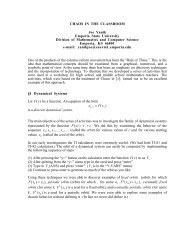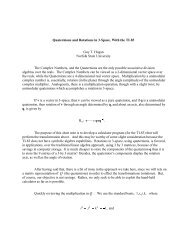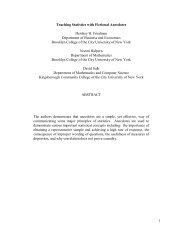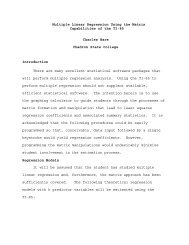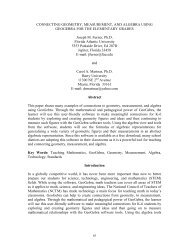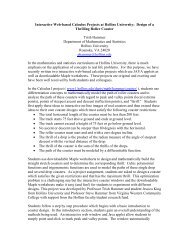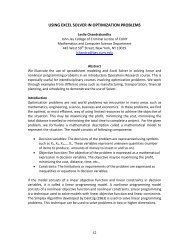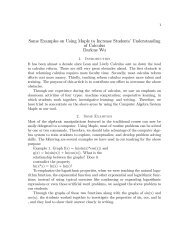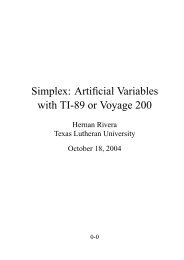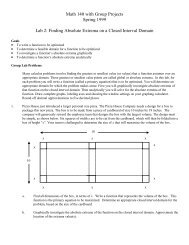Qualitative Problem Solving Strategies of First Order Differential ...
Qualitative Problem Solving Strategies of First Order Differential ...
Qualitative Problem Solving Strategies of First Order Differential ...
You also want an ePaper? Increase the reach of your titles
YUMPU automatically turns print PDFs into web optimized ePapers that Google loves.
1<strong>Qualitative</strong> <strong>Problem</strong> <strong>Solving</strong> <strong>Strategies</strong> <strong>of</strong><strong>First</strong> <strong>Order</strong> <strong>Differential</strong> Equations: The Case <strong>of</strong> AmyChris L. RasmussenUniversity <strong>of</strong> Maryland
2AbstractThis study explores one student’s understanding <strong>of</strong> qualitative methods <strong>of</strong> analysis for firstorder differential equations. The student demonstrated a strong graphical understanding <strong>of</strong>the derivative and used her prior knowledge <strong>of</strong> population modeling to make sense <strong>of</strong>various graphical representations. Despite this strong background knowledge, severalpotential difficulties related to qualitative methods <strong>of</strong> analysis are uncovered andpropositions regarding the sources <strong>of</strong> these difficulties are <strong>of</strong>fered. A misconceptioninvolving the interpretation <strong>of</strong> direction fields is suggested by the data, which in turn raisesquestions about the usefulness <strong>of</strong> phase lines in some recent reform-oriented curriculums.
4cognitive difficulties <strong>of</strong> first-year French university students when using geometric settingsto construct qualitative analyses.The purpose <strong>of</strong> this exploratory, interpretive study is to investigate one student’sunderstanding <strong>of</strong> qualitative methods <strong>of</strong> analysis <strong>of</strong> first order differential equations. Thequestions <strong>of</strong> interest in this study are:1) What does it mean to this student to qualitatively analyze a first order differentialequation?2) What strategies does this student use in a direction field-differential equationmatching activity?3) What characterizes this student’s understanding <strong>of</strong> stability <strong>of</strong> first order differentialequations?The results from this study will provide educators with one image <strong>of</strong> what theirstudents are understanding from this new approach, strategies they use, and the possibledifficulties they may be encountering. Knowledge <strong>of</strong> students’ understanding, strategies,and difficulties, when linked and synthesized with further studies in other contexts, can leadto increased communication between teacher and student, new insight into instructionalpractices, and revised and improved curriculum.Theoretical PerspectiveA brief but complete description <strong>of</strong> the researcher’s theoretical perspective on thenature <strong>of</strong> learning and understanding mathematics will assist the reader in understanding thechoices made regarding the research questions and the research methodology.Constructivism provides the overall perspective on how students learn and Hiebert andLefevre’s distinction between conceptual and procedural knowledge provides a usefulperspective on understanding mathematics.
5Understanding is assumed to be an ongoing activity, not a final accomplishment orattainment. In other words, “mathematical knowledge is not a thing that you have, but anactivity that you (might) engage in” (Dubinsky, 1994, p. 224). This perspective isconsistent with the writings <strong>of</strong> Piaget, who stressed knowing to be an adaptive activity, andwith von Glasersfeld’s theory <strong>of</strong> knowing, <strong>of</strong>ten referred to as constructivsim.Constructivism, as used here, is the belief that knowledge is constructed by the individualand that this construction is adaptive and influenced pr<strong>of</strong>oundly by our experiences and ourown cognitive lenses (Confrey, 1990; von Glasersfeld, 1995). Regarding the importance <strong>of</strong>social interactions in the construction <strong>of</strong> knowledge, the analysis reported here considers it amatter <strong>of</strong> “figure versus ground,” where the individual is the figure and the relationshipsamong individuals is the ground (Thompson, 1995, p. 127-128). Thus, the emphasis is onthe individual student and not on the social aspects or interactions.Constructivism deals essentially with the construction <strong>of</strong> conceptual knowledge.However, this does not imply that memorization and rote learning as useless, but rather aspotential means for learning other matters (von Glasersfeld, 1995). Von Glasersfeld doesnot expand upon what these other matters might be, but Hiebert and Lefevre’s distinctionbetween conceptual and procedural knowledge helps to clarify the discussion. Hiebert andLefevre (1986) characterize conceptual knowledge as “knowledge that is rich inrelationships. It can be thought <strong>of</strong> as a connected web <strong>of</strong> knowledge, a network in whichthe linking relationships are as prominent as the discrete pieces <strong>of</strong> information” (p. 3-4).Procedural knowledge is “made up <strong>of</strong> two distinct parts. One part is composed <strong>of</strong> theformal language, or symbol representation system, <strong>of</strong> mathematics. The other part consists<strong>of</strong> the algorithms, or rules, for completing mathematical tasks” (p. 6). In regard to this
6study, there are conceptual and procedural aspects to qualitative methods andunderstanding has been defined broadly enough to include both the conceptual andprocedural aspects. However, constructivism provides the most useful perspective whendealing with the conceptual aspects <strong>of</strong> understanding.From a constructivist’s perspective, the researcher’s interest will be focused on whatcan be inferred to be going on inside the student’s head rather than on overt responses. Theprimary techniques for exploring students’ understanding are careful observations and indepthinterviews with students.MethodIn order to provide in-depth information on this student’s understanding <strong>of</strong>qualitative methods <strong>of</strong> analysis, two semi-structured interviews were conducted. Eachinterview, which was audio-taped and transcribed by the researcher, consisted <strong>of</strong> two parts.The first part consisted <strong>of</strong> several questions aimed at uncovering what it means to Amy toqualitatively analyze a differential equation, strategies she might use, and the sources thatinfluenced this understanding. This provided an opportunity for the researcher to gain someinsight into Amy’s understanding prior to her solving the problems and it assisted theresearcher in interpreting her solutions. The second part consisted <strong>of</strong> one to two problemsdrawn from other reform oriented texts dealing with qualitative methods <strong>of</strong> analysis. Amywas asked to “think aloud” during her solution <strong>of</strong> these problems and was asked about herthinking and reasoning as needed.Triangulation <strong>of</strong> the interview data was accomplished through document analysis <strong>of</strong>her first exam and her Mathematica problem set dealing with the qualitative analysis <strong>of</strong> first
7order differential equations. The use <strong>of</strong> interviews in conjunction with document analysis isone way for the researcher to “develop insights on how subjects interpret some piece <strong>of</strong> theworld” (Bogdan & Biklen, 1992, p.96). The “piece <strong>of</strong> the world” <strong>of</strong> interest in this study isthe student’s understanding <strong>of</strong> qualitative methods <strong>of</strong> analysis <strong>of</strong> first order differentialequations. In addition, the researcher observed most <strong>of</strong> the class sessions dealing with firstorder differential equations in order to have a better sense <strong>of</strong> the environment in whichlearning took place.The SettingThe study reported here was carried out in Fall, 1995 semester in one section <strong>of</strong> anintroductory differential equations course at the University <strong>of</strong> Maryland, College Park. Theclass used the fifth edition <strong>of</strong> the textbook Elementary <strong>Differential</strong> Equations by Boyce &DiPrima and the supplemental text <strong>Differential</strong> Equations with Mathematica by Coombes,Hunt, Lipsman, Osborn, and Stuck. The philosophy <strong>of</strong> the supplemental text is as follows:• To guide students into a more interpretive mode <strong>of</strong> thinking.• To use a mathematical s<strong>of</strong>tware system to enhance students’ ability to computesymbolic and numerical solutions, and perform qualitative and graphical analysis<strong>of</strong> differential equations.• To develop course material that reflects the current state <strong>of</strong> differentialequations and emphasizes the mathematical modeling <strong>of</strong> physical problems.• To minimize the time required to learn to use the computer platform (Coombes,Hunt, Lipsman, Osborn, & Stuck, 1995, p. 5).Assignments from the supplemental text, which were the major source for learning aboutqualitative and graphical analysis, counted 20% towards the course grade.The class met for two 75 minute periods per week in a room with no computerresources and lecture was the predominant mode <strong>of</strong> instruction. One student from a class <strong>of</strong>approximately 25 was asked to participate in this study. The participant was a 26 year old
8graduate student named Amy (not her real name). Amy holds a bachelor degree incomparative religion and a master’s degree in interdisciplinary science studies, with aconcentration in environmental science. At the time <strong>of</strong> this study, Amy was a first yeargraduate student in fishery science. Her college mathematics background consisted <strong>of</strong> twosemesters <strong>of</strong> calculus at the University <strong>of</strong> Maryland during the 1994-95 school year. Priorto this course, she had never used a computer algebra system, but she had used wordprocessing, spreadsheet, and statistics programs. I asked Amy to participate in thisexploratory study since, as I had been her teaching assistant for both semesters <strong>of</strong> calculus, Iknew her to have a sound understanding <strong>of</strong> the subject, to be thoughtful and able toarticulate her thinking <strong>of</strong> complex subjects.Results and DiscussionThe results <strong>of</strong> the two interviews with Amy and the analysis <strong>of</strong> her Mathematicaproblem set and exam are discussed in the following three sections: graphs and fish,invented strategies, and notions <strong>of</strong> stability. The first section, graphs and fish, providessome insight into what it means to Amy to qualitatively analyze a differential equation,strategies she might use to qualitatively analyze a differential equation, and sources thatinfluenced this understanding. The second section, invented strategies, describes andinterprets Amy’s solution strategies on a direction field-differential equation matchingactivity. The final section, notions <strong>of</strong> stability, characterizes Amy’s understanding <strong>of</strong> theconcept <strong>of</strong> stability as it relates to first order differential equations.Graphs and Fish
9A central premise <strong>of</strong> the researcher’s theoretical orientation is that peoplereassemble information taken from the outside world in ways that allow them to makepersonal sense <strong>of</strong> it. One way to explore how people make sense <strong>of</strong> something is toinvestigate the meanings these things hold for them and the sources they cite as particularlyinfluential in the development <strong>of</strong> this understanding. Thus, before presenting Amy with thematching activity, it is useful to obtain some sense <strong>of</strong> what it means to her to qualitativelyanalyze a differential equation, strategies she might use, and the sources that influenced thisunderstanding.R: What does it mean to study a differential equation qualitatively?A: It means to be able to tell general properties. To be able to figure out generalproperties <strong>of</strong> the differential equation by looking at the graphs <strong>of</strong> solution curves orthe actual differential equation, the slopes and things like that. So it means to me tobe able to look at slopes and equilibrium and be able to tell equilibrium, whetherthings are decreasing or increasing.Determining the “general properties” <strong>of</strong> solutions is a component <strong>of</strong> any qualitativeanalysis and for Amy, these properties include an understanding <strong>of</strong> the nature <strong>of</strong> equilibriumsolutions, looking at slopes, and determining whether a solution is increasing or decreasing.During the second interview, Amy states that to understand a differential equation means to“understand the process the equation is describing, how something changes over time. Forme to understand that is to come up with a graphical image <strong>of</strong> how something changes.”Here we see that Amy’s concept <strong>of</strong> a qualitative analysis also includes anunderstanding that a differential equation models a dynamic process, one that changes overtime. The above suggests that graphical representations and an understanding <strong>of</strong> the“process the equation is describing” are two key themes in Amy’s understanding <strong>of</strong> aqualitative analysis.
10As Amy alludes to above, graphical images are an important component in herqualitative understanding <strong>of</strong> differential equations and she appears comfortable with andconfident in her ability to use graphical representations. Moreover, she appears to rely ongraphs to understand certain concepts. For example, when talking about the Euler method,Amy said, “I need a graph because that’s the only way I understood it.” When asked aboutthe influences on her ability to qualitatively analyze a differential equation, Amy cites herprevious calculus courses where she “got a good basis in understanding what derivativesand integrals meant graphically” and was “able to interchange the graph <strong>of</strong> a curve, itssolution, and its integral and seeing how to go from one to the other, to make thetransition.” She related this to the differential equations course, where she felt thesupplemental text had “a good little section on putting these ideas together with thedirection field.” Amy also emphasized her study <strong>of</strong> fish populations as a major influence.A: The biggest thing that has helped me is just my study <strong>of</strong> fish populations orunderstanding <strong>of</strong> populations and then with differential equations describe the rate<strong>of</strong> population growth. So when I look at a curve, I can sometimes think about itmore easily in terms <strong>of</strong> the rate <strong>of</strong> change <strong>of</strong> a population.....I already have agraphical understanding <strong>of</strong> the rate <strong>of</strong> change and now I’m learning the mathematicsthat’s behind it.When asked about other sources <strong>of</strong> influences, such as fellow students or thepr<strong>of</strong>essor, Amy said that she “hadn’t really talked to any <strong>of</strong> my classmates” and that “thepr<strong>of</strong>essor is helpful answering questions after class, but I’ve never gone to his extra helpsessions [<strong>of</strong>fice hours].” In regards to the lectures, Amy said, “the lectures are helpful, butthere it’s much more procedural than graphical.” The implication is that qualitativeanalyses, which rely heavily upon graphical interpretation, are something other thanprocedural and require a level <strong>of</strong> thinking beyond mimicking “how you do it.” However,
11other research I am currently working on documents how even “good” students like Amyfind ways to proceduralize certain qualitative analyses in a way that renders themconceptually meaningless.Graphical representations also play an important role in Amy’s description <strong>of</strong> thestrategies she would use to qualitatively analyze a differential equation. Amy mentionsthree different graphical representations from which she would be able to qualitativelyanalyze a differential equation--graphs <strong>of</strong> the solution curves, graphs <strong>of</strong> the differentialequation, and direction fields. Regarding graphs <strong>of</strong> the differential equation, Amy statesthat this method works only for autonomous differential equations, whereas one can useMathematica to plot the direction field for any differential equation, “even if Mathematicacan’t solve it.” It appears that Amy has a good understanding <strong>of</strong> when it is appropriate touse particular graphical representations and is beginning to understand the power andflexibility <strong>of</strong> Mathematica. By looking at the direction field, she says you get “a moreprecise idea <strong>of</strong> what solution curves look like depending on the initial values.”R: If you were given a differential equation and asked to discuss the system itdescribes, what would you do?A: The first thing I’d do, if I had Mathematica, I’d do a direction field because you canreally see what’s happening and then I’d say well, that’s like a fish population goingup and down or whatever, but they’re really not. Most differential equations don’treally look like that. They don’t really lend themselves to being interpreted aspopulation growth, but I’m kind <strong>of</strong> making a transition between only being able tobeing able to see bunches <strong>of</strong> fish getting larger and smaller to just seeing how afunction which can describe a physical, biological, or something or other, just be afunction in and <strong>of</strong> itself. Just that shows its behavior at the time.One explanation regarding Amy’s attempt to make this “transition” draws fromHiebert and Lefevre’s discussion on how relationships between pieces <strong>of</strong> mathematicalknowledge can be established. At the reflective level,
12relationships are constructed at a higher, more abstract level than the pieces <strong>of</strong>information they connect. Relationships at this level are less tied to specificcontexts. They <strong>of</strong>ten are created by recognizing similar core features in pieces <strong>of</strong>information that are superficially different (Hiebert & Lefevre, 1986, p. 5).From this perspective, it appears that Amy’s “transition” is an attempt to move from thespecific context <strong>of</strong> modeling fish populations to a more abstract level.Invented <strong>Strategies</strong>The second portion <strong>of</strong> the first interview was a direction field-differential equationmatching activity taken from an article describing the reform-oriented course at BostonUniversity (see Blanchard, 1994). This type <strong>of</strong> activity does not appear anywhere in thetext or in the supplemental text and requires no new knowledge or understanding andtherefore provides an opportunity to illuminate Amy’s problem solving strategies and herunderstanding <strong>of</strong> the relationship between direction fields and differential equations.
131. Match the direction field with the differential equation.a) dydte) dydt= t −1 b) dydt2= y + yf) dydt= t +1 c) dydt= y +1 d) dydt= 1−2= yy ( −1 ) g) dy = y− t h) dy = y+tdtdtyPlot 13210-1-2-3-3 -2 -1 0 1 2 3Plot 33210-1-2-3-3 -2 -1 0 1 2 33210-1-2Plot 2-3-3 -2 -1 0 1 2 33210-1-2-3Plot 4-3 -2 -1 0 1 2 3Amy begins the activity by expressing some discomfort with notation.A: This is tricky.R: Why do you say it’s tricky?A: Because the dy/dt. Oh, I guess it’s all the same. I hate it when they change dx/dt,dy/dt. I’m so set in what’s the x-axis, what’s the y-axis and then they switch themaround and then I get confused about which is the dependent and independentvariable, but any rate....t minus.....It appears that Amy is not referring to the notation in this activity, as everything iswritten as dy/dt=f(t,y), but rather to the text and supplemental text, which <strong>of</strong>ten alternatesbetween dy/dt, dx/dt, and dy/dx. It appears that the dy/dt notation is more natural for Amy,as the following discussion indicates.
14R: Which notation makes the most sense to you in terms <strong>of</strong> modeling a real worldphenomenon?A: dy/dt, the change in y as a function <strong>of</strong> t, is that right?R: And why is that?A: Because I think <strong>of</strong> things in terms <strong>of</strong> time changing because most population analysisis based on dy, the change, the rates are all changing something according to timeand so that’s how, as I was saying, how I initially got my understanding <strong>of</strong>differential equations is based on rate.Amy’s last comment above provides additional evidence that she is attempting tomake the transition from just seeing bunches <strong>of</strong> fish going up and down to seeing how asolution to a differential equation is a “function in and <strong>of</strong> itself.” It remains an openquestion as to whether an alternating use <strong>of</strong> notation is a help or a hindrance in thistransition.Amy begins her analysis by examining the direction fields for equilibrium solutions,moving easily between the graphical and symbolic representations. Moreover, recall thather response to the question, “What does it mean to study a differential equationqualitatively?” she said it “means to me to be able to look at slopes and equilibrium and beable to tell equilibrium.” The following excerpt illustrates her ability to look at slopes andequilibrium, demonstrating her understanding <strong>of</strong> the derivative and flexibility in using bothgraphical and symbolic representations.A: Ok, now are some <strong>of</strong> these [referring to the 8 differential equations] not thedirection field?R: We’ve got 4 direction fields and 8 differential equations.A: Ok, so problem (d) is definitely not one <strong>of</strong> them because there is no equilibrium at 1.So I can cross that out. <strong>Problem</strong> (c) there is an equilibrium at -1 so that probablymatches the fourth direction field, but I should check the slope to make sure that’sOk. So at 0 the slope is 1 and that looks right. I checked the slope just by pluggingin 0 for y and got 1 for dy/dt and came up with that. So I’d say 4 is (c).
15Next, she turns her attention to the differential equation in (b), inventing a theory forfinding vertical asymptotes.A: Well, now wait a second here, I hate these things. t = ...yes that’s right, now if.. I’mlooking at (b) with dy/dt = t + 1. If t =..., if I find it’s equal to 0 then I’m thinkingthis means there’s a vertical asymptote, is that right?R: Which problem is this?A: For (b),R: For (b).A: If you set it equal to 0, then.... wait a second (mumbling). That’s right, because Idon’t see a vertical asymptote at -1, I’m going to discount that. Actually I don’t seea vertical asymptote anywhere that’s explicit. I still question my theory aboutvertical asymptotes, I’m not sure.R: What’s your theory about vertical asymptotes?A: That if you set dy/dt =0, so 0 = t +1, and you get t=-1 that means there should be avertical asymptote at -1. I mean I believe that for finding horizontal asymptotes, butI’ve never, I haven’t come across a problem that says there are vertical asymptotesand you can find them this way, so I don’t know if it’s true.R: Ok, so that’s a theory you’ve just developed?A: Yeah.Amy appears to be searching for a strategy to deal with differential equations, suchas the one in (b), that depend only on time. One interpretation <strong>of</strong> her “theory” is she isovergeneralizing a strategy to find constant solutions for autonomous differential equations,which do not depend on time. The differential equations in (c), (d), (e), and (f) are allautonomous and will therefore have equilibrium solutions whenever dy/dt=0. This followsdirectly from the interpretation <strong>of</strong> the derivative as slope. Although she has demonstrated asolid understanding <strong>of</strong> the derivative as slope, she appears to see no conflict orcontradiction between this and her theory, which would call for a function to have near zeroslope as it approached a vertical asymptote.Amy continues to work with the differential equations and attempts to apply hertheory <strong>of</strong> vertical asymptotes as well as the strategy for determining equilibrium solutions
16for autonomous equations. Based on her theory, she determines that the differentialequations in (a) and (b) should have vertical asymptotes. She immediately follows this upby concluding that the differential equation in (e) should have a horizontal asymptote atzero.A: So I did the easy ones first, the ones with easy equilibrium, and so now I’m lookingat the ones that don’t have simple equilibrium. So, I think that (e), (a), and (b), aredefinitely...should have..... (a) and (b) should have vertical asymptotes according tomy theory, and then (e) should have a horizontal asymptote at zero and at -1(matches (e) up with 2).Amy easily slips back and forth between applying her theory on vertical asymptotesand finding horizontal asymptotes for autonomous equations. Amy continues her analysisby examining the two “strange” equations (g) and (h). Apparently the differential equationsin (g) and (h) are strange because they involve both y and t in the right hand side.A: That leaves me with these two strange equations. I set 0 = y-t, so y=t and 0=y+t, soy=-t. So to me, I don’t know why, but I think my instinct is to go with y=t for 1 justbecause there’s something like a y=x line down the center <strong>of</strong> the graph, but itdoesn’t go through the origin, so it’s a little confusing. I don’t know why I think itshould go through the origin, but it’s not. So we can do a different way <strong>of</strong> checkingthings. When t is 1 and y is 1 the slope should be 0, and that’s not true here. When tis 2 and y is 2, wait a minute, so what I was doing is plugging numbers along theaxis into the equation and seeing what slope I would get for that point. And I don’treally know if you can do that.R: How do you think direction fields are generated?A: By plugging in numbers along the axis and finding the slope. So at (1,1) that’ssaying the slope <strong>of</strong> the solution curve is 0, so that’s right. So if I plug in numbers inthis equation, I should expect that these slopes <strong>of</strong> the little arrows in the directionfield match at that point. And so according to that theory, there’s nothing here witha slope <strong>of</strong> 0 at (1,1), (2,2) (3,3). Oh wait, yeah there is. Well maybe. I’m going totry a different point. Wouldn’t it be funny if I actually use the tick marks? If x is 1and y is 2, the slope should be about 1, so it’s close (matches (g) with 1).In the above, Amy actually skirts around with the concept <strong>of</strong> an isocline, butquestions this theory because “it’s not going through the origin.” It appears that she thinks
17the “arrow” should be centered at the point in question, rather than having its foot at thepoint. The method <strong>of</strong> isoclines was not covered in class or in the textbook, so this suggeststhat the strategy she begins to pursue is self-generated. Amy next decides to “test (h) on 3because it’s the only one I haven’t ruled out yet.” In order to recap her decisions thus far, Iasked her to explain why she ruled out the various choices, which seemed to provide herwith an opportunity to reflect on what it means for a differential equation to beautonomous.R: Can you explain why you ruled out the other ones? I mean obviously the ones youruled out because you matched them up correctly, but the other ones you’ve ruledout, can you explain why you ruled those out?A: Ok, there’s another reason why I can rule out the other ones that I just thought <strong>of</strong>and that’s because these, (a), (b), and (e), only have one variable on the one side <strong>of</strong>the equation--they’re autonomous, is that correct?R: What does autonomous mean to you?A: Autonomous means to me it’s only, that the equations only vary by one variable.R: Ok, not quite. Autonomous means there is only one variable on the right hand side,but it also means that that variable is the dependent variable--not time.A: Oh!R: So an autonomous equation does not depend on....A: Time. So (e) is autonomous, (f) is autonomous, (c) is autonomous, and (d) isautonomous.R: Some people say that if a differential equation is autonomous, the direction field iseasy to graph, why do you think they say that?A: Because since it doesn’t vary with time if you find one slope along a y = c line thenthe slope is the same all the way across. So 2 and 4 are direction fields <strong>of</strong>autonomous equations because the slopes <strong>of</strong> the lines do not change as t changes,but 1 and 3 are not autonomous, so 3 has to be (a), (b), or (h). so, I’ll check (a) and(b), though I’m hesitant because I really don’t want to blow my vertical asymptotetheory.R: Is this vertical asymptote theory something you developed by yourself?A: Yeah, definitely, just right now.Although the original intent <strong>of</strong> the interview was to try and capture what she coulddo on her own, without my intervention, my questions and interaction most likely influenced
18her solution strategy. After this brief clarification <strong>of</strong> what the term autonomous means,both symbolically and graphically, Amy rethinks some <strong>of</strong> her choices.A: Using the same thinking about the autonomous equations and if it only depends onthe change, and t is the independent variable. Ok, so if dy/dt=t-1, 3 could be it. Thedifferential equation only varies with t and so you would get equal slopes along linest=c , c = a number. And if you had a differential equation that depended on both yand t then you would not get equal slopes on any lines <strong>of</strong> y=c or t=c.R: Is that consistent with your choices so far?A: So far it is, so it could be. So the vertical asymptote theory is blown, in place <strong>of</strong>another. So when t=0, y', the slope, equals -1. We can discount (a) for 3.R: Why can we discount (a)?A: Because when t=0 the slope should be -1 and this is obviously from a graph that’sincreasing, so it can’t be a negative value.Amy then checks the value <strong>of</strong> dy/dt in (b) for several values <strong>of</strong> t and decides that (b)matches the direction field labeled 3. Throughout the above activity, Amy demonstratedflexible and versatile thinking. She essentially discovered a special case <strong>of</strong> the isoclinemethod for sketching direction fields and she immediately transferred the idea behindgraphing direction fields for autonomous differential equations to differential equations thatvary only with time and to those that involve both time and the dependent variable. Thisanalysis then led to the rejection <strong>of</strong> her vertical asymptote theory. In other words, Amydecided her theory on vertical asymptotes was no longer “viable.” From a constructivistperspective, “the conception <strong>of</strong> truth as the correct representation <strong>of</strong> states or events <strong>of</strong> anexternal world is replaced by the notion <strong>of</strong> viability. To the constructivist, concepts,models, theories, and so on are viable if they prove adequate in the contexts in which theywere created” (von Glasersfeld, 1995, p. 7-8). Thus, Amy’s vertical asymptote theory wasno longer adequate and was replaced by “another,” which may also prove to be inadequate.In terms <strong>of</strong> the distinction between conceptual and procedural knowledge as described by
19Hiebert and Lefevre (1986), Amy’s conceptual knowledge assumed an “executive controlfunction” (p. 13). That is, her conceptual knowledge acted as “validating critic,” judgingthe reasonableness <strong>of</strong> the outcome to the vertical asymptote theory and ultimately rejectingit.Notions <strong>of</strong> StabilityAmy’s understanding <strong>of</strong> stability was examined from two related, but slightlydifferent perspectives. The first aspect <strong>of</strong> stability examined deals with the stability <strong>of</strong> adifferential equation itself and the second aspect deals with the asymptotic stability <strong>of</strong>equilibrium solutions. Triangulation <strong>of</strong> the data sources in this study provided convergentevidence <strong>of</strong> Amy’s understanding <strong>of</strong> stability, but it also yielded some inconsistency in thedata. As Mathison (1988) points out, triangulation <strong>of</strong> data sources in qualitative research<strong>of</strong>ten leads to inconsistency among the data and it is the goal <strong>of</strong> the researcher to providemeaningful propositions regarding the data. The following discussion describes the datacollected and an explanation regarding the inconsistent data is <strong>of</strong>fered.The first source <strong>of</strong> data regarding Amy’s understanding <strong>of</strong> stability comes from anactivity in the Mathematica problem set. This activity read as follows:Solve the initial value problem y'− y = cosx, y( 0 ) = c. Use Mathematica to graphsolutions for c = -0.9,-0.8,...,-0.1,0. Display all the solutions on the same intervalbetween x = 0 and an appropriately chosen right endpoint. Explain what happens tothe solution curves for large values <strong>of</strong> x. (Hint: You should identify three distincttypes <strong>of</strong> behavior.) Now, based on this problem, and the material in Chapters 5 and6, discuss what effect small changes in initial data can have on the global behavior <strong>of</strong>solution curves.Amy’s response, which follows below (minus the two graphs she generated), provides aclear and accurate answer to these questions.
20The behavior <strong>of</strong> the solution curves for y’-y=cos(x) at large values <strong>of</strong> x dependsupon the value <strong>of</strong> the initial value c. When -0.9
21equation to your observed data, whether it’s in physics or biology. If you have anequation that is sensitive, then your initial conditions you establish have to beextremely accurate, especially in biology where its really hard and <strong>of</strong>ten times inpopulation growth you can only estimate or assume the initial conditions so you cannever really know (the exact initial conditions). So if it’s a sensitive differentialequation that you’re using, with quite possibility incorrect initial conditions, yourjust going to get an outrageous answer anyway.R: Where do you feel you’ve gotten most <strong>of</strong> your understanding <strong>of</strong> sensitivity to initialconditions?A: The homework assignments from Mathematica and my understanding <strong>of</strong> fisheryscience. When I was doing the Mathematica problem about sensitively, it made a lot<strong>of</strong> sense to me and it helped me to think about it in terms <strong>of</strong> population and fishstock.The above statement is accurate and well said. What is <strong>of</strong> particular relevance tounderstanding Amy’s concept <strong>of</strong> stability is the perspective from which she considers theissue <strong>of</strong> sensitivity to initial conditions. When Amy speaks <strong>of</strong> trying to fit an equation (adifferential equation) to some observed data, she is viewing the subject <strong>of</strong> differentialequations as a means for modeling observed phenomena. From a modeling perspective, it isperhaps more useful to think <strong>of</strong> the differential equation itself as being stable or unstable,as opposed to thinking <strong>of</strong> a particular solution to an initial value problem as stable orunstable and Amy provides a valid argument for why this perspective is useful.In addition to demonstrating a solid understanding <strong>of</strong> the notion <strong>of</strong> stability as itapplies to a differential equation, Amy also demonstrates a well-connected understanding <strong>of</strong>stability as it applies to the equilibrium solutions to an autonomous differential equation.Two <strong>of</strong> the activities from the Mathematica problem set involve autonomous differentialequations and require the student to determine the equilibrium solutions and whether theseparticular solutions are stable or unstable. In the first activity, Amy uses Mathematica toplot the direction field for the differential equation y'= 3siny+ y−2, uses the equationsolver to determine the equilibrium, and correctly interprets the direction field to determine
22the stability <strong>of</strong> each equilibrium solution. In the second activity, Amy uses Mathematica toplot the direction field for x' = x( 1−ln x)( x−3 ), which appears to show a continuum <strong>of</strong>equilibrium solutions for 3
23Solutions starting to the left <strong>of</strong> x ≅ -2.5 in the lower left quadrant, and solutionsstarting to the left <strong>of</strong> x ≅ -.5 in the upper quadrant appear to be stable. Theyconverge to y = 0, and their limit as x→∞ is 0.Solutions starting to the right <strong>of</strong> x ≅ -2.5 in the lower left quadrant, and solution(s)starting to the right <strong>of</strong> x ≅ -.5 in the upper quadrant appear to be unstable. Theydiverge from the equilibrium value, and as x→∞, their limit →∞ .Why, despite Amy’s self-acknowledged preference for graphical representations, didshe incorrectly interpret this direction field? Solution curves such as Amy describes abovewould necessarily cross and hence violate the uniqueness theorem. However, examination<strong>of</strong> students’ understanding <strong>of</strong> the uniqueness theorem remains for further investigation.Was Amy’s incorrect response caused by simply “misreading” the direction field? If so,what aspects <strong>of</strong> the direction field did she find difficult to interpret? I spoke with hershortly after the exam and she explained how she was unsure what was happening near thepositive x-axis. This is understandable as this region is somewhat sparsely populated witharrows. Amy mentioned she actually plugged in a few points into the differential equation(much like she did in the matching activity), but found no contradiction between the slopesand her description. Not having any evidence to contradict her initial impression, shedecided she was correct. That is, her interpretation remained viable. However, another,perhaps more serious problem, is that she believes once solutions appear to become stable,or approach an equilibrium solution in an asymptotic manner, they will remain close to theequilibrium solution. Evidence to support this hypothesis has been found in other researchthat I am currently working on. Moreover, the use <strong>of</strong> phase lines, which are the onedimensionalanalog to the phase plane and used in part to help students qualitatively analyzefirst order autonomous differential equations, may in fact foster this misconception.Although not part <strong>of</strong> the curriculum in this course, phase lines are used in some recent
24reform-oriented texts (see Blanchard, Devaney, & Hall, 1996; Lomen & Lovelock, 1996)and the results here suggest the need for further investigation regarding the use <strong>of</strong> phaselines.For part (b), Amy gave the following response, which is also flawed.At y(-3), the solution is y(x)=0. This is an equilibrium solution which is very stablesince it never changes. As x→∞, y(x) →0.In the two previous problems from the Mathematica problem set, Amy was able to identifythe stability and/or instability <strong>of</strong> the equilibrium solutions to autonomous differentialequations. However, she was unable to transfer this ability to this problem, where thedifferential equation is not autonomous. Recall the matching activity discussed in thebeginning <strong>of</strong> this paper where she called the two differential equations in which both thedependent and independent variable appeared in the right hand side “strange.” Perhaps the“strangeness” <strong>of</strong> this situation led her to fall back on her understanding <strong>of</strong> stability as aconcept that applies to a set <strong>of</strong> solutions and thus conclude that this one solution is “verystable since it never changes.” In support <strong>of</strong> this hypothesis, her strong and thoroughdescription <strong>of</strong> why sensitivity to initial conditions is important suggests that the aspect <strong>of</strong>stability which refers to a differential equation is dominant in her mind.ConclusionsAmy demonstrated a solid understanding <strong>of</strong> and ability to qualitatively analyze firstorder differential equations and a strong and coherent concept <strong>of</strong> stability. There werethree main sources which she cited as major influences: her strong conceptual and graphicalunderstanding <strong>of</strong> the derivative as slope or rate <strong>of</strong> change, her prior knowledge <strong>of</strong>
25population modeling, and the Mathematica supplement. She continually made reference toher preference for graphical representations as the best means for her to understand aconcept and her knowledge <strong>of</strong> fishery science appeared to provide a “hook” on which shecould hang her emerging understanding <strong>of</strong> differential equations. Moreover, Amy appearedto recognize the need to move beyond just seeing “bunches <strong>of</strong> fish getting larger andsmaller” to just seeing how a solution to a differential equation can be a “function in and <strong>of</strong>itself.” Despite her solid conceptual understanding <strong>of</strong> the derivative and her understanding<strong>of</strong> modeling population growth with differential equations, several potential difficulties wereuncovered. These difficulties included:• an overgeneralization <strong>of</strong> the term autonomous to include first order differentialequations that only involve the independent variable.• an overgeneralization <strong>of</strong> a strategy used to sketch and/or interpret direction fields forautonomous differential equations. This led to her “vertical asymptote theory.”• an incorrect interpretation <strong>of</strong> the behavior <strong>of</strong> solutions based on the direction field.Despite attempts to disprove this interpretation, her initial image remained viable. Onepossible explanation for this incorrect interpretation is the misconception that oncesolutions appear to become stable, or approach an equilibrium solution in an asymptoticmanner, they will remain close to that equilibrium solution.• a strong notion <strong>of</strong> stability <strong>of</strong> a differential equation that possibly prevented her fromcorrectly interpreting the stability <strong>of</strong> an equilibrium solution for a non-autonomousdifferential equation.questions:Besides uncovering some possible difficulties, this study also raised further• To what extent are these difficulties resilient to instruction and/or other curriculums?• How widespread is the misconception that a solution which approaches an equilibriumsolution in an asymptotic manner must remain asymptotic to that equilibrium solution?Does the use <strong>of</strong> phase lines foster that misconception?
26• What role should class time play in the development <strong>of</strong> students’ ability to interpret anduse the various graphical representations which are now so readily available withtechnology?• What characterizes the understanding and difficulties <strong>of</strong> students who do not initiallyhave a strong conceptual and graphical understanding <strong>of</strong> the derivative?• What characterizes the understanding and difficulties <strong>of</strong> students who do not initiallyhave an awareness <strong>of</strong> the power <strong>of</strong> differential equations to model real worldphenomena?The growing number <strong>of</strong> innovative curriculums, new learning theories, and theincreasingly availability <strong>of</strong> technology provides an extraordinary opportunity to deepenstudents’ understanding <strong>of</strong> differential equations, to provide insight about the behavior <strong>of</strong>solutions, and to give students an idea <strong>of</strong> how the subject is relevant to other disciplines.Continued research efforts in all aspects <strong>of</strong> the teaching and learning <strong>of</strong> mathematics ingeneral and differential equations in particular is needed to realize these goals.
27ReferencesArtigue, M. (1992). Cognitive difficulties and teaching practices. In G. Harel, & E.Dubinsky (Eds.), The concept <strong>of</strong> function: Aspects <strong>of</strong> epistemology and pedagogy. (pp.109-132). (MAA Notes Number 25). Washington, DC: Mathematical Association <strong>of</strong>America.Blanchard, P. (1994). Teaching differential equations with a dynamical systemsviewpoint. The College Mathematics Journal, 25, 385-393.Blanchard, P., Devaney, R., & Hall, R. (1996). <strong>Differential</strong> equations (preliminaryed.). Boston: PWS.Bogdan, R. C., & Biklen, S. K. (1992). <strong>Qualitative</strong> research for education. Boston:Allyn and Bacon.Borrelli, R., & Coleman, C. (1996). <strong>Differential</strong> equations: A modeling perspective.New York: Wiley.Coombes, K. R., Hunt, B. R., Lipsman, R. L., Osborn, J. E., & Stuck, G. J. (1995).<strong>Differential</strong> Equations with Mathematica. New York: Wiley.Confrey, J. (1990). What constructivism implies for teaching. In R. B. Davis, C. A.Maher, &N. Noddings, (Eds.), Constructivist Views on the Teaching and Learning <strong>of</strong>Mathematics. Journal for Research in Mathematics Education Monograph No. 4 (pp. 107,122).Douglas, R. G. (Ed.). (1986). Toward a lean and lively calculus. (MAA NotesNumber 6). Washington, DC: Mathematical Association <strong>of</strong> America.
28Dubinsky, E. (1994). A theory and practice <strong>of</strong> learning college mathematics. In A.H. Schoenfeld (Ed.), Mathematical Thinking and <strong>Problem</strong> <strong>Solving</strong> (pp. 221-243). Hillsdale,NJ: Erlbaum.Fraga, R. (Ed.). (1993). Calculus problems for a new century. (MAA Notes Number28). Washington, DC: Mathematical Association <strong>of</strong> America.Hiebert, J., & Lefevre, P. (1986). Conceptual and procedural knowledge inmathematics: An introductory analysis. In J. Hiebert (Ed.), Conceptual and proceduralknowledge: The case <strong>of</strong> mathematics. (pp. 1-27). Hillsdale, NJ: Erlbaum.Kostelich, E., & Armbruster, D. (1995). Introductory differential equations: Fromlinearity to chaos (preliminary ed.). Reading, MA: Addison-Wesley.Lomen, D., & Lovelock, D. (1996). Exploring differential equations via graphicsand data. (preliminary ed.). New York: Wiley.Mathison, S. (1988). Why triangulate? Educational Researcher 17 (2), 13-17.Thompson, P. W. (1995). Constructivism, cybernetics, and information processing:Implications for technologies <strong>of</strong> research on learning. In L. P. Steffe, & J. Gale (Eds.),Constructivism in Education (pp. 123- 270). Hillsdale, NJ: Erlbaum.Tucker, T. W. (Ed.). (1990). Priming the calculus pump: Innovations and resources.(MAA Notes Number 17). Washington, DC: Mathematical Association <strong>of</strong> America.von Glasersfeld. E. (1995). A constructivist approach to teaching. In L. P. Steffe, &J. Gale (Eds.), Constructivism in Education (pp. 3-15). Hillsdale, NJ: Erlbaum.West, B., Strogatz, S., McDill, J. M., & Cantwell, J. (in press). Interactivedifferential equations. Reading, MA: Addison-Wesley.



